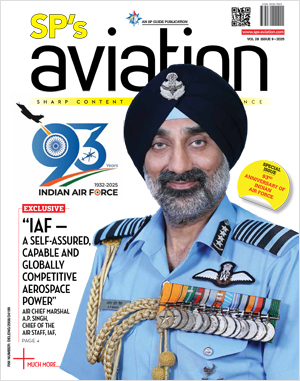INDIAN ARMED FORCES CHIEFS ON OUR RELENTLESS AND FOCUSED PUBLISHING EFFORTS
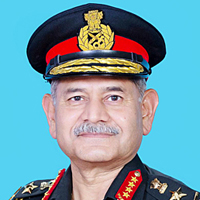
The insightful articles, inspiring narrations and analytical perspectives presented by the Editorial Team, establish an alluring connect with the reader. My compliments and best wishes to SP Guide Publications.

"Over the past 60 years, the growth of SP Guide Publications has mirrored the rising stature of Indian Navy. Its well-researched and informative magazines on Defence and Aerospace sector have served to shape an educated opinion of our military personnel, policy makers and the public alike. I wish SP's Publication team continued success, fair winds and following seas in all future endeavour!"

Since, its inception in 1964, SP Guide Publications has consistently demonstrated commitment to high-quality journalism in the aerospace and defence sectors, earning a well-deserved reputation as Asia's largest media house in this domain. I wish SP Guide Publications continued success in its pursuit of excellence.
- A leap in Indian aviation: Prime Minister Modi inaugurates Safran's Global MRO Hub in Hyderabad, Calls It a Milestone
- All about HAMMER Smart Precision Guided Weapon in India — “BEL-Safran Collaboration”
- India, Germany deepen defence ties as High Defence Committee charts ambitious plan
- True strategic autonomy will come only when our code is as indigenous as our hardware: Rajnath Singh
- EXCLUSIVE: Manish Kumar Jha speaks with Air Marshal Ashutosh Dixit, Chief of Integrated Defence Staff (CISC) at Headquarters, Integrated Defence Staff (IDS)
- Experts Speak: G20 Summit: A Sign of Global Fracture
The AMCA Race
The AMCA programme is envisioned as a deep penetration combat aircraft specifically designed for the Indian Air Force (IAF), incorporating advanced stealth features to significantly enhance India's air power projection capabilities – conducting both air-to-air and air-to-surface missions
 |
The Author is Former Director General of Information Systems and A Special Forces Veteran, Indian Army |
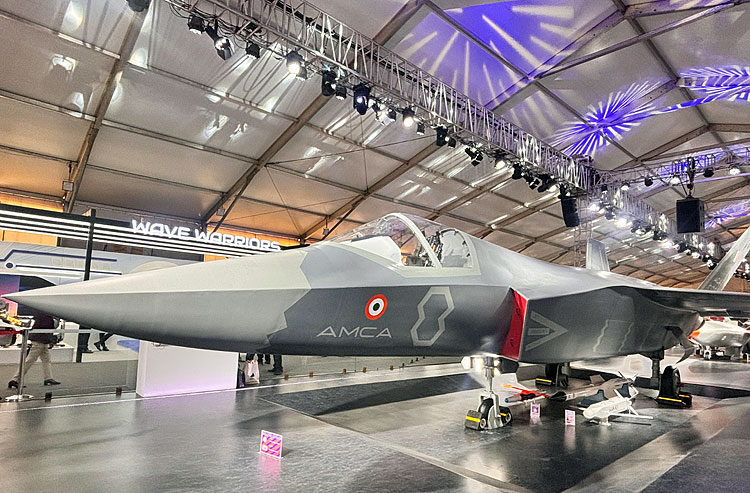
On May 27, 2025, Defence Minister Rajnath Singh officially approved the Advanced Medium Combat Aircraft (AMCA) Programme Execution Model; operationalising the project that was given initial Cabinet Committee on Security (CCS) approval more than three years ago in March 2024. This sets the stage for development of India's first indigenous fifth-generation stealth fighter aircraft. The Aeronautical Development Agency (ADA), under the Defence Research and Development Organisation (DRDO), is designated as the primary executing authority. Initial development cost of the project is approximately ₹15,000 crore. The AMCA programme is envisioned as a deep penetration combat aircraft specifically designed for the Indian Air Force (IAF), incorporating advanced stealth features to significantly enhance India's air power projection capabilities – conducting both air-to-air and air-to-surface missions.
The AMCA Programme Execution Model caters for equal participation opportunities for both private and public sector entities; encouraging broader industry participation while maintaining strategic control over critical technologies, and allowing entities to participate independently, through joint ventures (JVs), or as consortia, provided they comply with Indian laws and regulations. The Ministry of Defence (MoD) will fund both Hindustan Aeronautics Limited (HAL) and a competitively selected private sector partner to develop AMCA prototypes, with the superior design ultimately becoming the baseline for production contracts.
The Ministry of Defence (MoD) will fund both Hindustan Aeronautics Limited (HAL) and a competitively selected private sector partner to develop AMCA prototypes, with the superior design ultimately becoming the baseline for production contracts
The twin-engine, medium-weight stealth fighter AMCA is being developed, weighing 27 tonnes to accommodate larger payload of conventional weapons in its internal weapons bay; AMCA is to be paired with 'Gandiva' missiles and potential integration of a new BrahMos variant having speed of Mach 7 and range 1,000–1,400 km. The aircraft will initially be powered by General Electric F414 engines, with ongoing negotiations for local manufacturing arrangements that will support the programme's self-reliance objectives. Earlier projections suggested a prototype rollout by 2024 with first flight in 2025, but current estimates indicate that prototype's first flight is anticipated in 2028. The IAF has indicated its intention to procure approximately 120 AMCA aircraft; 40 AMCA MK-1 variants and 80 more advanced AMCA MK-2 variants. Mark 1 will incorporate some imported technology to validate core capabilities, while Mark 2 aims for full indigenisation with advanced AI, hypersonic missile integration, and possibly an AI-assisted copilot.
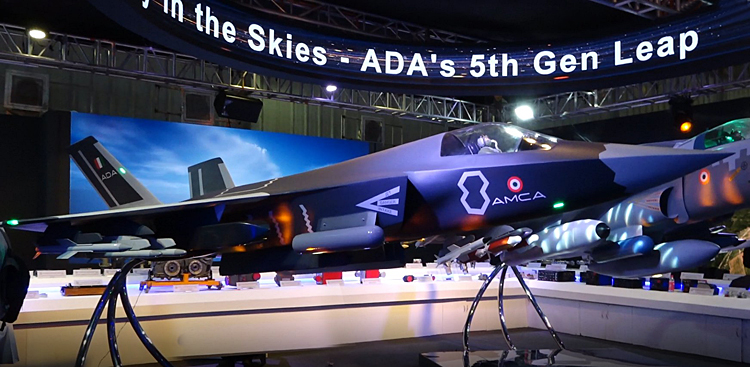
The French firm Safran has proposed co-development of a 10kN thrust engine with complete IP control by India, coupled with a commitment to establish a centre of excellence in gas turbine technology in India. The DRDO is also in discussions with General Electric (GE), Rolls-Royce, and Safran to co-develop a 110kN thrust engine tailored for the AMCA. Japan has also offered its IHI XF9-1 Engine for India's AMCA. The prototype XF9-1, delivered in 2018, generates over 11 tonnes (107 kN) dry thrust and exceeds 15 tonnes (147 kN) with afterburner. Designed for adaptability, the XF9-1 has a potential maximum thrust of 20 tonnes (196 kN). The XF9-1 would provide a 5.5 generation thrust to the AMCA. At the same time, budgetary estimates for the engine will require R&D investment close to ₹40-50,000 crore ($4 to $5 billion).
The IAF has indicated its intention to procure approximately 120 AMCA aircraft; 40 AMCA MK-1 variants and 80 more advanced AMCA MK-2 variants
The Kaveri engine, which was undergoing trials in Russia including its integration with the indigenous Ghatak UCAV, is also being considered for the AMCA by the DRDO. However, veteran IAF fighter pilot Group Captain Ajay Ahlawat has pointed out that the current Kaveri engine variant cannot meet future thrust requirements. He calls for developing a new indigenous fighter jet engine, 'Kaveri 2.0' to power the AMCA and Tejas Mk 2. Interestingly, Larsen & Toubro (L&T) has put forward an ambitious proposal to develop a fully indigenous 110kN thrust jet engine for fighter aircraft to power the Tejas Mk2 and the AMCA. According to news reports of June 5, 2025, 24 indigenous companies have responded to a call from Hindustan Aeronautical Limited (HAL) to join a consortium for the production of the AMCA; as the DRDO prepares to issue an Expression of Interest (EoI) to identify a lead production partner for the AMCA programme.
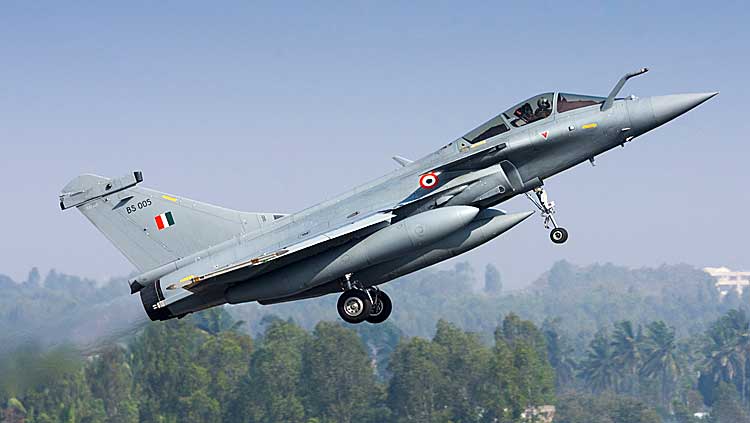
China has fast-tracked export of its fifth-generation J-35 fighter jets to Pakistan and the first lot is reportedly being delivered in the first quarter of 2026. Now there are unconfirmed reports that China and Pakistan have jointly test-flown the first Pakistan-liveried J-35A 'Gyrfalcon' stealth fighter over the Karakoram. The flight was carried out with Chinese and Pakistani pilots aboard, fully integrated with Beidou satellite command, AWACS uplink, and ground-based stealth-tracking denial systems. According to an Islamabad-based European defence attaché, "We knew the J-35 would be exported. But we didn't expect Pakistani pilots to be inside the cockpit before full PLAAF deployment. That's unprecedented. This isn't just cooperation. It's full-spectrum fusion."
According to news reports, 24 indigenous companies have responded to a call from Hindustan Aeronautical Limited (HAL) to join a consortium for the production of the AMCA
A veteran IAF Air Marshal, reportedly spoke anonymously to a UK-based defence publication, saying, "If Chinese and Pakistani pilots are flying J-35As in combat configurations, it fundamentally changes the balance. The Rafale edge we built is gone. Stealth has reached our borders." According to a Chinese defence analyst quoted in Global Times, said, "Pakistan is not just a customer. It is a doctrinal partner. The J-35's deployment tests reflect the maturing of a joint deterrence framework."
According to recent reports, Dassault has finally agreed for India's Rafale fleet to be armed with the BrahMos-NG. But Rafales are fourth-generation fighters and India has lost Rafale jets in Operation 'Sindoor', which India is loath to admit. However, foreign media has been reporting the same and Indonesia is reviewing its $8.1 billion deal to import 42 Rafales from France. Moreover, a study published by the Institut Français des Relations Internationales (IFRI) reports that the predominantly Rafales-based French Air Force would only be able to sustain operations for three days in a full-scale conflict with Russia.
China has already test flown its sixth-generation fighter jet, Pakistan is scheduled to get the fifth-generation J-35s early next year, and the AMCA prototype is scheduled to take off only in 2028
The IAF is down to just about 31 fighter squadrons against the authorised 42; a critical shortage especially with mounting threats to India's national security. Addressing the recent Confederation of Indian industries (CII) Annual Business Summit 2025 recently, IAF Chief Air Marshal A.P. Singh, in presence of Defence Minister Rajnath Singh, said, "We have to be ready now to be future ready. So that is the concern that yes, I can look at the next 10 years we will have certain more output from the Indian industry and the DRDO but what is required today is required today. We need to quickly get our act together...maybe get into some quick 'Make in India' programmes so that we can achieve that 'now ready' part of it." He also warned the industry against overpromising on delivery schedules. "Timelines are a big issue. Once a timeline is given, not a single project that I can think of has been completed on time. So, this is something where we have to look at."
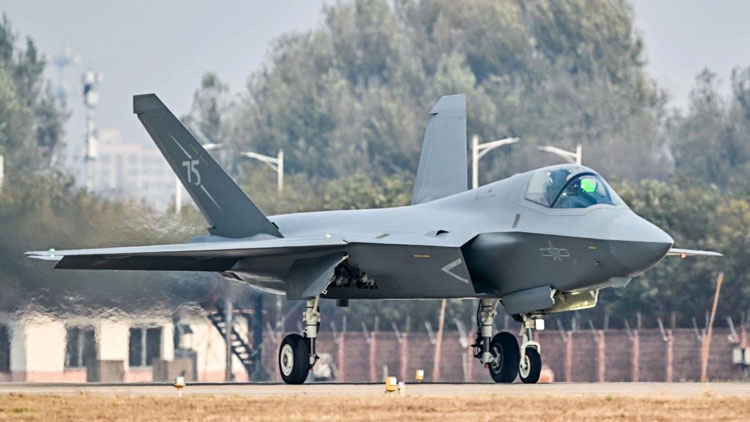
We have a situation now where China has already test flown its sixth-generation fighter jet, Pakistan is scheduled to get the fifth-generation J-35s early next year, and the AMCA prototype is scheduled to take off only in 2028. India needs to seriously address the intervening period. Russia has offered its fifth-generation Su-57 fighter jet to India with full transfer of technology (ToT), super 30 customisation and local production in HAL; which could be considered as an option under 'Buy and Make'. We also need to consider developing the AMCA as a 5.5-generation, or better still, a sixth-generation fighter jet if we want to catch up with China. As mentioned earlier, Japan has invited India to its next-gen aircraft, which it is developing in collaboration with the UK and Italy under the Global Air Combat Programme (GCAP). However indigenous development under 'Make in India' will be the better option.





